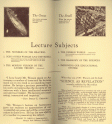There is another aspect of James’s purification of religion that is central to my argument, however, and it has to do with how he turned to an empirical study of experience as a new foundation for his spirituality. As older warrants for belief waned, as the Bible and even Jesus faded into a demythologized past, where could people turn to reestablish faith in God or immortality? The answer was science. When properly domesticated by religious believers, scientific procedures were ways of seeing spiritual things with certainty. With them we saw things truly, and seeing was believing. When James saw people around him falling into fits and trances, he believed. There was, he thought, something to it.
James wasn’t the only believer turning to science to appropriate its more certain ways of knowing, seeing, and believing.

John M. Watson’s starting point was similar to James’s in two ways. First, though he was willing to hold onto more of Christianity than James, he also believed that older ways of thinking about religion were superstitious, simple-minded and old-fashioned. Second, like James he believed that by studying the essence of religion in experience we could make religious experience more real to people and catch real glimpses of the divine spirit acting in these experiences.
But Watson also turns to other sciences to elicit another set of emotions that we might call religious: awe and wonder. In Watson’s Science as Revelation he insisted that a new vital faith might be had by studying not just human nature but also the beauty and lawfulness of nature in general. Science, in other words, was the alembic through which modern spiritual sensibilities were developed. “The new conception of God in the light of all the sciences as the intelligent energy, with many forms but with a single identity that fills the universe, is a thousand times more convincing than our former conceptions of Deity.” Watson used science to develop a new picture of God. “By the ladder of the sciences we may rise step by step, without the slightest break or gap,” Watson wrote, “from the simplest form of matter and energy and from nature at its zenith obtain the most sublime, beautiful and uplifting religious concepts.” God is energetic—a common belief among twentieth-century religious liberals—and the appropriate response to that God is openness, wonder, and astonishment.
There is a lot to be astonished about in Watson’s lecture tour of the universe, and participants evidently were appropriately awed. This is clear from the promotional pamphlet. Science was showing us that there was more to the world than meets the eye. Telescopes demonstrated that the world was more vast and wonderful than we had ever thought. And microscopes brought into focus another world within our world, a world of intricate crystals and microscopic ecologies. Both new technologies yielded “beautiful and wonderful revelations.” Both proved that there were things that existed beyond the range of our vision and both helped us see them. What else might be out there that we couldn’t yet see? Were there unseen dimensions where other creatures resided? You had to wonder.

Conversations about higher dimensions had already begun in the late nineteenth century, when scientists used higher dimensional math to understand better the universe’s laws. Beginning at the turn of the twentieth century, theologians and writers borrowed these ideas to try to “prove” the existence of heaven, explain the mechanisms involved in spirit communication or understand better the fate of dearly departed souls. Films and books about higher dimensions also made people wonder. This 1959 film was only one of the many imaginative narratives that depicted scientists with new powers and access to other worlds.
Page 2 of 3 | Previous page | Next page